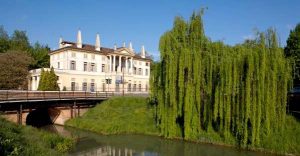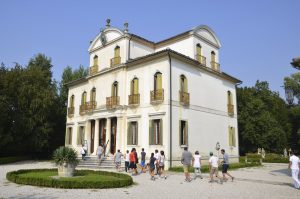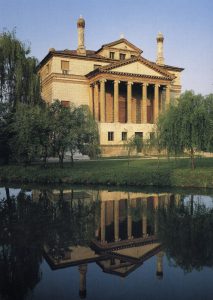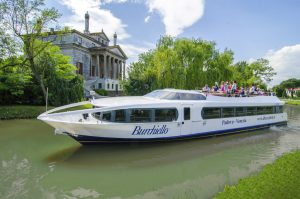 Sailing the river down from Padua to Venice, travellers set out from the Portello, the old river port with a beautiful staircase built in the 16th century and painted by Canaletto, and an outstanding portal made of Istria stone. This portal reminds of a Triumphal Arch, with eight columns and a clock turret. This was the main stop for the boats and barges that linked Padua and its province with the Venice lagoon, sailing on the rivers and waterways.
Sailing the river down from Padua to Venice, travellers set out from the Portello, the old river port with a beautiful staircase built in the 16th century and painted by Canaletto, and an outstanding portal made of Istria stone. This portal reminds of a Triumphal Arch, with eight columns and a clock turret. This was the main stop for the boats and barges that linked Padua and its province with the Venice lagoon, sailing on the rivers and waterways.

Sailing on the Piovego and along the old sixteenth-century walls with their imposing ramparts, immersed in the thick and lush vegetation, barges pass under the old Graissi bridge and get to Noventa Padovana, an old river port of Padua. Once boats used to stop here, and passengers and goods reached Padua on carts and carriages. This port lost its role when the Piovego canal was opened, which took into Padua.
 But countless patrician villas bear witness to its importance. Among these is the solitaire and superb Villa Giovanelli, extensively frescoed, built at the end of the 17th century by the Giovanelli family. Its structure matches Palladian features with Longhena’s innovative architectural trends; the peculiar and monumental pronaos of pentagonal shape, with tall Corinthian columns and a tympanum decorated with statues, and the imposing staircase added by Massari in 1738 make its external aspect magnificent and spectacular.
But countless patrician villas bear witness to its importance. Among these is the solitaire and superb Villa Giovanelli, extensively frescoed, built at the end of the 17th century by the Giovanelli family. Its structure matches Palladian features with Longhena’s innovative architectural trends; the peculiar and monumental pronaos of pentagonal shape, with tall Corinthian columns and a tympanum decorated with statues, and the imposing staircase added by Massari in 1738 make its external aspect magnificent and spectacular.
Past the locks at Noventa Padovana and Stra, to overcome the water drop, travellers reach Stra where the Brenta Canal takes its origin from the Brenta river.
 The town is dominated by the grandiose Villa Pisani, the renown Doge’s Palace on the mainland, a sumptuous villa ordered by the Pisani family as their status symbol; rather than a villa, it is a palace decorated with mighty sculptures on its façade and by the most famous venetian painters of 18th-century inside.
The town is dominated by the grandiose Villa Pisani, the renown Doge’s Palace on the mainland, a sumptuous villa ordered by the Pisani family as their status symbol; rather than a villa, it is a palace decorated with mighty sculptures on its façade and by the most famous venetian painters of 18th-century inside.
 In 1735 Alvise Pisani, ambassador of Venice to Paris at the time of Louis 14 and of the splendour of the Palace of Versailles, charged architect Francesco Maria Preti with the redesign of the main part of the villa in Stra, of which the Exedra, the Stables, the Orangery and the imposing fence wall had already been built.
In 1735 Alvise Pisani, ambassador of Venice to Paris at the time of Louis 14 and of the splendour of the Palace of Versailles, charged architect Francesco Maria Preti with the redesign of the main part of the villa in Stra, of which the Exedra, the Stables, the Orangery and the imposing fence wall had already been built.
 Among the numerous rooms on the piano nobile (the reception floor) are some masterpieces, like the Bacchus room by Guarana; the Pompeiana room, the rooms in Empire style, while the most important and extraordinary is the one dedicated to dance, with the ceiling frescoed by Giovanbattista Tiepolo to celebrate the glories of the Pisani family. This was to be his last work in Italy, the last gift of this great painter of skies and angels. The villa is protected by a very vast park where, besides century-old plants, visitors can admire the coffee pavilion on the ice-house hill, and the famous Maze where Gabriele D’Annunzio set the cruel love games of Stelio Effrena, the main character of his novel “The flame of life”, with Foscarina. The large pond facing the Stables was built more recently for hydraulic tests. After the fall of the Venice Republic, the villa became the property of Napoleon I, then of the Savoia royal family and, finally, of the Italian State that has made a National Museum of it.
Among the numerous rooms on the piano nobile (the reception floor) are some masterpieces, like the Bacchus room by Guarana; the Pompeiana room, the rooms in Empire style, while the most important and extraordinary is the one dedicated to dance, with the ceiling frescoed by Giovanbattista Tiepolo to celebrate the glories of the Pisani family. This was to be his last work in Italy, the last gift of this great painter of skies and angels. The villa is protected by a very vast park where, besides century-old plants, visitors can admire the coffee pavilion on the ice-house hill, and the famous Maze where Gabriele D’Annunzio set the cruel love games of Stelio Effrena, the main character of his novel “The flame of life”, with Foscarina. The large pond facing the Stables was built more recently for hydraulic tests. After the fall of the Venice Republic, the villa became the property of Napoleon I, then of the Savoia royal family and, finally, of the Italian State that has made a National Museum of it.
 Thirty very beautiful villas rise one after the other from Stra to Mira, and often their main façade overlooks the waterway.
Thirty very beautiful villas rise one after the other from Stra to Mira, and often their main façade overlooks the waterway.
Many of these are still inhabited and cannot therefore be visited; among these some are worth a mention: villa Soranzo for the frescoes by Benedetto Caliari, the brother of Paolo aka “il Veronese”; villa dei Lazzara Pisani called “la Barbariga”, for its architecture; villa Ferretti Angeli for the project by Vincenzo Scamozzi; Palazzo Foscarini that hosted Lord Byron, and villa Contarini dei Leoni visited by Henry III King of France.
 The navigation continues to Dolo, an old coastal village, a typical town in Venetian style renown for its Mills, the Squero (boatyard) and the old Basin, the subject of famous painters like Bernardo Bellotto, Canaletto and Francesco Guardi.
The navigation continues to Dolo, an old coastal village, a typical town in Venetian style renown for its Mills, the Squero (boatyard) and the old Basin, the subject of famous painters like Bernardo Bellotto, Canaletto and Francesco Guardi.
 Past the Dolo lock, the navigation continues amidst the green of the weeping willows, the Villas and the swing bridges to reach Mira, celebrated by Goldoni in 1760:
Past the Dolo lock, the navigation continues amidst the green of the weeping willows, the Villas and the swing bridges to reach Mira, celebrated by Goldoni in 1760:
“Here we are in nice Mira, decorated with beautiful gardens and palaces. We leave the canal and breathe, walk, lunch and then we go back. The famous horse is harnessed and pulls the barge along the Brenta Canal. There are people smoking, others singing or playing, and others talk about the poor lunch.”
 Mira has the highest concentration of villas; it is the town of the famous façades overlooking the Canal, of the verdant bights, of the unblemished corners where the weeping willows touch the water of the waterway.
Mira has the highest concentration of villas; it is the town of the famous façades overlooking the Canal, of the verdant bights, of the unblemished corners where the weeping willows touch the water of the waterway.
 Worth mentioning is Villa Barchessa Valmarana, with a wide colonnade dominating the garden. The complex is particularly agreeable thanks to its solemn colonnade, its happy location and the indoor frescoes dating from the second half of the 18th century and ascribed to a follower of Tiepolo’s, a certain Michelangelo Schiavoni called “il Chiozzotto”. Among these, “The glorification of the Valmarana family” stands out.
Worth mentioning is Villa Barchessa Valmarana, with a wide colonnade dominating the garden. The complex is particularly agreeable thanks to its solemn colonnade, its happy location and the indoor frescoes dating from the second half of the 18th century and ascribed to a follower of Tiepolo’s, a certain Michelangelo Schiavoni called “il Chiozzotto”. Among these, “The glorification of the Valmarana family” stands out.
 Villa Widmann is a typical summer residence of the 1700’s with its delightful park, a true jewel of the Riviera del Brenta. The palace is the result of a deep-reaching transformation made by the Widmann family around 1750 on the pre-existing Sceriman’s house designed by architect Tirali; this explains the slightly rococo style of the main body. Inside the villa, the decorative cycle celebrates the glories of this important German family, the Widmanns, who moved from Carinthia to Venice at the end of the 1500’s and who has been in the golden book of the Venetian aristocracy since 1646. Special attention should be devoted to the fresco celebrating the “glory of the Widmann family” ascribed to Guarana, and the one about the “abduction of Helen” by Angeli; both can be seen in the beautiful ballroom. The Widmanns are also remembered for commissioning several comedies to great Carlo Goldoni, including the famous cycle called “Smanie per la villeggiatura” (Pining for vacation). In the Widmann family there flew the Rezzonico family, which died away with Carlo, or Pope Clement XIII. Also the Widmann died away towards the middle of the past century with Elisabetta Widmann Rezzonico, the wife of senator and earl Pietro Foscari of whom there remains the bronze coat of arms in the curvilinear tympanum of the façade. The park, the “barchessa” (a long, porticoed farm building) and other units are all wonderful.
Villa Widmann is a typical summer residence of the 1700’s with its delightful park, a true jewel of the Riviera del Brenta. The palace is the result of a deep-reaching transformation made by the Widmann family around 1750 on the pre-existing Sceriman’s house designed by architect Tirali; this explains the slightly rococo style of the main body. Inside the villa, the decorative cycle celebrates the glories of this important German family, the Widmanns, who moved from Carinthia to Venice at the end of the 1500’s and who has been in the golden book of the Venetian aristocracy since 1646. Special attention should be devoted to the fresco celebrating the “glory of the Widmann family” ascribed to Guarana, and the one about the “abduction of Helen” by Angeli; both can be seen in the beautiful ballroom. The Widmanns are also remembered for commissioning several comedies to great Carlo Goldoni, including the famous cycle called “Smanie per la villeggiatura” (Pining for vacation). In the Widmann family there flew the Rezzonico family, which died away with Carlo, or Pope Clement XIII. Also the Widmann died away towards the middle of the past century with Elisabetta Widmann Rezzonico, the wife of senator and earl Pietro Foscari of whom there remains the bronze coat of arms in the curvilinear tympanum of the façade. The park, the “barchessa” (a long, porticoed farm building) and other units are all wonderful.
Villa Corner, the stage of ostentatious receptions and of sumptuous and extremely long parties of the same-name family (some say they lasted up to 8 days); Villa Foscarini, where Lord Byron spent two years (1817 – 1818).
 The barge continues then to Oriago, in the past a theatre of the wars between Padua and Venice that still preserves its Termine (the Boundary Post), an ancient column marking the border and leaning against the corner of a modest dwelling. It was built in 1374 together with more boundary posts, in various locations, to mark the boundaries of the territory during the never-ending wars between the Carrara family, the lords of Padua, and Venice.
The barge continues then to Oriago, in the past a theatre of the wars between Padua and Venice that still preserves its Termine (the Boundary Post), an ancient column marking the border and leaning against the corner of a modest dwelling. It was built in 1374 together with more boundary posts, in various locations, to mark the boundaries of the territory during the never-ending wars between the Carrara family, the lords of Padua, and Venice.
Here the barge moors at the restaurant Il Burchiello, where travellers can lunch at an agreed price, or can freely have their lunch as they please.
Side by side with many villas that have the typical Venetian look is Villa Gradenigo, an old 16th-century villa of which only the central body has survived, which is decorated with frescoes by Benedetto Caliari, the brother of Veronese.
 Back to the barge travellers reach Malcontenta, where they can admire all the elegance and monumentality of Villa Foscari called the Malcontenta, one of the masterpieces of the genius of Andrea Palladio. The Malcontenta is a typical example of a temple-villa, with a monumental pronaos reflecting in the waters of the Canal, melancholy and superb amidst the weeping willows.
Back to the barge travellers reach Malcontenta, where they can admire all the elegance and monumentality of Villa Foscari called the Malcontenta, one of the masterpieces of the genius of Andrea Palladio. The Malcontenta is a typical example of a temple-villa, with a monumental pronaos reflecting in the waters of the Canal, melancholy and superb amidst the weeping willows.
It was built for Nicolò and Alvise Foscari and it still belongs to the descendants of that noble family. The legend goes that the villa owes its name “Malcontenta” (never happy) to the unhappy soul of the wife of one of the Foscari men, who was exiled here against her will.
 The magnificent pronaos with its six beautiful Ionic columns rests on a high base, which can be accessed from two staircases. The names of the brothers Nicolò and Luigi Foscari are carved in the building pediment. It was designed by the great architect from Vicenza, Andrea Palladio, who wanted to look after its construction personally since 1560. The two sides are sober and severe; thoroughly different is the lively modern style of the southern façade looking onto the park. Here the wide semi-circular window that reminds of the old thermal baths is surrounded by many openings in various sizes, by a broken pediment and various cornices; the marmorino plaster is worked in such a way as to look like white stone ashlar.
The magnificent pronaos with its six beautiful Ionic columns rests on a high base, which can be accessed from two staircases. The names of the brothers Nicolò and Luigi Foscari are carved in the building pediment. It was designed by the great architect from Vicenza, Andrea Palladio, who wanted to look after its construction personally since 1560. The two sides are sober and severe; thoroughly different is the lively modern style of the southern façade looking onto the park. Here the wide semi-circular window that reminds of the old thermal baths is surrounded by many openings in various sizes, by a broken pediment and various cornices; the marmorino plaster is worked in such a way as to look like white stone ashlar.
 Four oriental-style chimneys stand out on the roof. The villa has three floors: the kitchens and the dinettes are on the ground floor, followed by the piano nobile and the mezzanine. Over the entrance door an inscription in Latin recalls, among other events, the visit of Henry III of Valois, King of France, in 1574. The piano nobile is skilfully made of six rooms of different sizes, arranged around an extraordinary central room with a cross vault.
Four oriental-style chimneys stand out on the roof. The villa has three floors: the kitchens and the dinettes are on the ground floor, followed by the piano nobile and the mezzanine. Over the entrance door an inscription in Latin recalls, among other events, the visit of Henry III of Valois, King of France, in 1574. The piano nobile is skilfully made of six rooms of different sizes, arranged around an extraordinary central room with a cross vault.
All the walls are decorated with an outstanding cycle of frescoes made by artists like Gianbattista Franco and Giambattista Zelotti, a friend and partner of Paolo Veronese.
 Sailing from the Malcontenta, the Burchiello passes the Moranzani lock and Fusina to reach the lagoon.
Sailing from the Malcontenta, the Burchiello passes the Moranzani lock and Fusina to reach the lagoon.
Past the island of San Giorgio in Alga, it enters the Giudecca canal: to the right the very high building of Molino Stucky, then the Church of the Redentore, a masterpiece of Palladio’s sacred architecture and, finally, the church of Le Zitelle.
Steering between Punta della Dogana and the church of San Giorgio Maggiore, the Burchiello enters the magic marble scenario of St. Mark’s Basin, where this fantastic trip comes to an end.







 ">
">
 ">
">
 ">
">